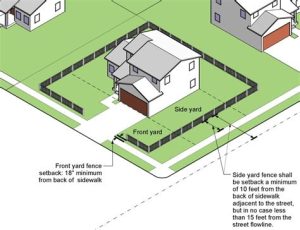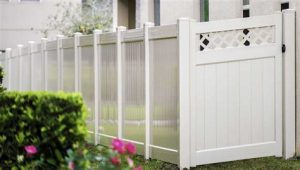Learn how to install a chain link fence with steps for assessing ground condition, preparing posts, adjusting for uneven terrain, and securing the fence.Installing a chain link fence can be a rewarding project, offering both security and an enhanced aesthetic for your property. However, when faced with uneven ground, the task can become a bit more complex. Navigating dips, slopes, and other irregularities requires careful planning and execution to ensure that your fence stands strong and looks great. In this blog post, we will guide you through the essential steps needed to install a chain link fence on uneven terrain. From assessing the ground condition to securely attaching the fence fabric, we’ll provide you with practical tips and expert advice to achieve a durable and visually appealing result. Whether you’re a DIY enthusiast or a first-time installer, this comprehensive guide will equip you with the knowledge you need to tackle your fencing project with confidence.
Assessing the Ground Condition
Before embarking on the journey of installing a chain link fence, it is essential to thoroughly assess the ground condition. The ground’s topography and soil quality play a significant role in determining the feasibility and durability of your fence installation.
Start by examining the area where you plan to construct the fence. Look for signs of uneven terrain, as this can complicate the installation process. Identifying slopes, dips, and bumpy surfaces helps in planning how to adjust the fence posts accordingly. You may also want to check for rocks, roots, or other obstructions that can impede digging.
Using a level can assist you in determining the slope of the land. An easy method is to lay a long board across the area and check for levelness at various points. It’s vital to ensure that all sections of the chain link fence are properly aligned, and this begins with a solid understanding of the ground conditions.
Preparing the Fence Posts
Installing a chain link fence on uneven ground requires meticulous preparation to ensure a sturdy and long-lasting structure. The first step is to assess the layout of your fence line to determine the correct spacing for your fence posts. Typically, posts should be spaced about 5 to 10 feet apart, depending on the height of your fence and the specific requirements of your installation.
Once the spacing is determined, you can begin the installation of the fence posts. For uneven terrain, it is essential to dig post holes that are deeper and slightly wider at the bottom to accommodate any changes in soil consistency. A rough guide is to dig the holes to a depth of at least one-third the length of the posts, ensuring they are firmly anchored against lateral movement. Use a level to confirm that each post is vertical, correcting as necessary to ensure a straight alignment throughout the entire fence line.
For areas of significant uneven terrain, you may need to utilize adjustable post brackets or set posts at varying heights to maintain a consistent top line for the fence fabric. This method allows for better alignment of the chain link while adapting to the contours of the ground below.
Adjusting for Uneven Terrain
When installing a chain link fence, adjusting for uneven terrain is a critical step that can greatly impact the fence’s installation and overall appearance. Uneven ground presents various challenges, but with the right techniques and tools, you can achieve a level and secure fence.
One effective method for addressing uneven surfaces is to utilize a post level during the installation process. By inserting the fence posts into the ground and using the level, you can ensure that all posts are plumb, regardless of the ground’s irregularities. If the ground rises or drops unexpectedly, you may need to dig deeper or use additional fill material to stabilize the posts.
In some cases, using adjustable fence brackets can be beneficial. These brackets can help accommodate slight differences in height and provide the necessary flexibility to keep the chain link fabric taut. Additionally, consider pre-measuring the distance between posts to account for variations in ground elevation; this will allow for a more uniform look and reduce the risk of sagging fabric.
| Technique | Description |
|---|---|
| Post Level | Ensures fence posts are vertical even on sloped surfaces. |
| Adjusted Brackets | Provide flexibility for height adjustments, accommodating uneven ground. |
| Pre-measuring Distance | Helps plan for variations in |
Attaching the Chain Link Fabric
Once your fence posts are securely in place, it’s time to focus on attaching the chain link fabric. This step is crucial for ensuring that your fence remains sturdy and functional. Here’s a step-by-step guide to help you through the process.
Begin by unrolling the chain link fabric along the sections of the fence where it needs to be attached. Make sure the fabric is taut and free of twists. Next, align the bottom of the chain link fabric with the top of your fence posts. You can use helper tools like a fence puller to maintain tension as you work.
To secure the fabric, you’ll use fence ties, which are generally made of wire. Start at one end of the fabric and begin attaching it to the posts. Place a tie around both the chain link fabric and the post, making sure to twist it tightly, but not so much that it damages the fabric. Continue this process along the length of the fence, ensuring each tie is spaced about 12 inches apart for optimal support.
After you’ve secured the fabric to all the posts, take a step back and inspect your work. The chain link should appear straight and taut, providing the necessary rigidity for the fence. If any sections seem loose, you may need to adjust by redoing the ties or adjusting the tension of the fabric.
Finally, once you’re satisfied with how everything looks, give a gentle pull to the chain link fabric to ensure all connections are secure. Your fence is almost complete, and with the fabric properly attached, you’re just a few steps away from enjoying the benefits of your newly installed chain link fence!
Securing the Fence in Place
Once you have completed the installation of your chain link fence, it’s crucial to secure the fence in place to ensure it lasts for years to come. Properly securing your fence will help withstand weather conditions and potential impacts, keeping your property safe and well-defined.
One of the primary methods of securing a chain link fence is using concrete footings for your posts. This involves digging holes that are approximately 3 to 4 feet deep and filling them with a concrete mix. Make sure the posts are vertically aligned before the concrete sets. This provides a solid base, especially on uneven terrain, where additional stabilization may be required.
Additionally, consider using tension wire at the bottom of the fence. This technique helps to keep the chain link fabric taut and prevents sagging over time. For added security, you can install barbed wire on top of the fence, which acts as a deterrent for intruders. Always remember to check local zoning laws and regulations regarding fence heights and materials used.
Lastly, ensure that you perform regular maintenance checks on your fence. Inspect for any signs of wear, rust, or loose fittings. Addressing these issues promptly will prolong the life of your fence and maintain its appearance.
Frequently Asked Questions
What materials are needed to install a chain link fence on uneven ground?
You will need chain link fabric, metal posts, top rails, tension bars, wire ties, gate hardware, concrete, and tools like a post-hole digger, level, and fence puller.
How do you prepare the site for installing a chain link fence on uneven terrain?
First, mark the fence line with stakes and string. Then, clear the area of debris and vegetation, and measure the height differences to plan for proper post placement.
What is the best way to level posts when installing a chain link fence on uneven ground?
You can use either longer posts to accommodate the height difference or install a slope with shorter sections between posts, ensuring they remain level with the ground.
Can you install a chain link fence on a slope?
Yes, you can install a chain link fence on a slope by using a method called racking, where the fabric is adjusted to follow the slope while the posts remain vertical.
What should be done if there are significant dips or rises in the ground?
For significant dips, you may need to use shorter sections of fence fabric and place the posts accordingly to create a stepped effect. For rises, ensure the posts are tall enough to accommodate the height.
How do you secure a chain link fence on uneven ground to prevent leaning?
Ensure that the posts are set deeply in concrete and use a bracing system if necessary. Additionally, tension wires can help stabilize the sections of fabric.
What common mistakes should be avoided when installing a chain link fence on uneven ground?
Avoid neglecting to check the angle and height of the posts frequently, as well as using inadequate materials or not preparing the site thoroughly, which can lead to an unstable fence.





